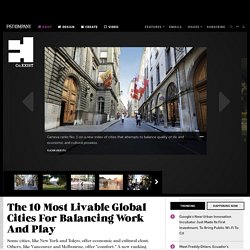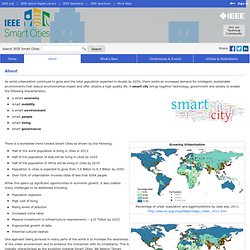

Japón echa a andar su primera ciudad inteligente. Unas 400 personas son las primeras en vivir en una ciudad inteligente de Japón.

Fujisawa Sustaintable Smart Town se encuentra a unos 50 km de Tokio y fue construida en 19 hectáreas de terreno con una inversión de $1.300 millones. Tokio fue calificada, precisamente, como una de las ciudades más inteligentes del 2014, según el Cities in Motion Index, elaborado en Barcelona. Según un comunicado de Panasonic, esta firma lideró el 50% de las operaciones de la nueva ciudad inteligente. También participaron otras siete empresas estadounidenses y japonesas en la construcción. El objetivo fue crear una vida sin residuos en la que las familias generen su propia energía. En cada casa hay una pantalla que funciona como un portal de información con todos los servicios para la comunidad. La cuidad tiene un control de iluminación mediante sensores y cámaras de vigilancia que se activarán con base en el flujo de personas y vehículos.
The 10 Most Livable Global Cities For Balancing Work And Play. How do the world’s biggest cities stack up against each other in terms of their livability?

Every day seems to bring a different sort of ranking, and comparing the different rankings can end up highlighting more about the rankings themselves than any given city on them. A new study, published in the World Review of Science, Technology, and Sustainable Development, tries to make sense of where seven different global city livability rankings overlap and why. Among the seven, it also examines its own new index, which unsurprisingly, it evaluates as the most "balanced" of the group. According to the authors, who are three researchers from the Asia Competitive Institute in Singapore, the University of California, Davis, and Curtin University in Australia, existing major livability indices can be divided into two groups.
The second group are the rankings that value pleasant living, such as a mild climate, easy transit, and clean environment, which the paper calls the "comfort club. " IEEE Smart Cities. As world urbanization continues to grow and the total population expected to double by 2050, there exists an increased demand for intelligent, sustainable environments that reduce environmental impact and offer citizens a high quality life.

A smart city brings together technology, government and society to enable the following characteristics: a smart economysmart mobilitya smart environmentsmart peoplesmart livingsmart governance There is a worldwide trend toward Smart Cities as shown by the following: Half of the world population is living in cities in 2013Half of the population of Asia will be living in cities by 2020Half of the population of Africa will be living in cities by 2035Population in cities is expected to grow from 3.6 Billion to 6.3 Billion by 2050.Over 50% of urbanization involves cities of less that 500K people While this opens up significant opportunities in economic growth, it also creates many challenges to be addressed including: Event Chair: Victor M.
Gilles Betis. Smart Cities - State of Green. By 2050, more than 6 billion people will live in urban areas.

This development calls for ‘smart’ approaches to ensure that cities are optimized for economic activity, energy consumption, environmental impact and ‘the good life’. The road towards a smart and more sustainable city is long termed planning and design. This requires rethinking – we have to think smart. It is necessary to define the challenges, ask the relevant questions, and choose the best tools. Cities’ impact on the global economy and climate Growing cities across the world face the challenge of combining competitiveness and sustainable urban development. 6 dimensions to a ‘smart’ city Whether developing new cities from scratch or rebuilding existing cities, the challenge is to ensure that the city becomes more livable, economically successful, and environmentally responsible.
Smart Cities Stakeholder Platform. There are many definitions of smart cities, from the infusion of ICT into urban systems to intelligent design and technological optimization to reach full sustainability.

We have blogged and shared on What is a Real Smart City: The recent study, Mapping Smart Cities in EU, suggesting to the EIP on Smart Cities some kind of instructions on smart cities. To our mind, it might be a good sample of what is not a true smart city and how it shouldn’t be developed. A Smart City is NOT one with at least one initiative addressing one or more of the following six characteristics: Smart Governance, Smart People, Smart Living, Smart Mobility, Smart Economy and Smart Environment. A Smart City is NOT city seeking to address public issues via ICT-based solutions on the basis of a multi-stakeholder, municipally based partnership. A real or true smart city is a unified urban entity with three critical layers/levels/spaces, all planned, developed and managed as its integral parts: Cgc-alemadigroup-tareq-alemadi.